
By Carolyn E. Grygiel, PhD, MBA, CPRM, MPM
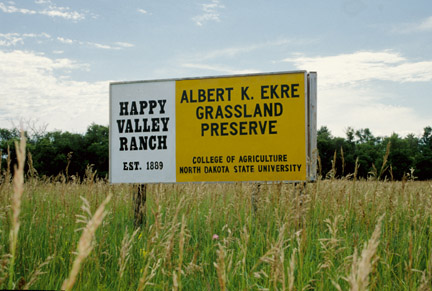
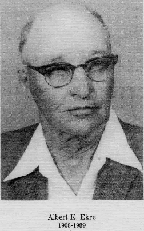
Albert Ekre bequeathed more than a beloved farmstead to the NDSU College of Agriculture, Food Systems, and Natural Resources he bequeathed a vision for its role in the future of agriculture. His gift will be with us forever and his vision of land stewardship will be nurtured by young minds in their study of sound ecological management practices.
Albert Ekre's gift to the NDSU College of Agriculture, Food Systems, and Natural Resources began with a telephone call in July of 1987. Ralph L. Trom, a Kindred, North Dakota banker and good friend of Mr. Ekre, telephoned Dr. Roald Lund, who at the time was Dean of the College of Agriculture and said, "I have a bank customer who would like to make a gift to the Agricultural College." With only this information, Dr. Lund, Clayton Haugse who at the time was Chairman of the Department of Animal and Range Sciences, and Roy Pederson of the NDSU Development Foundation, drove to Kindred to meet with Mr.Trom and learn more about the proffered gift. Upon arriving at the bank in Kindred, the four gentlemen then proceeded to Happy Valley Ranch and a meeting with Albert Ekre.
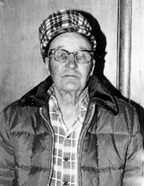
This first meeting with Mr. Ekre was conducted in the cool shade of the tall, old oak trees that grew near his white frame house. This would be one of many such meetings to which these old trees would bear witness and they would become part of the legacy Albert Ekre was determined to leave to the people of North Dakota. Albert cared about such things as trees and land and he also cared about young people and the future of agriculture.
In the humid heat of a prairie afternoon in late July, these four men accompanied Mr. Ekre on a drive through his land. They made several stops that afternoon as he explained how each piece of land was used, when it was purchased, and how much it had cost. As the miles and hours rolled past, it became apparent that Mr. Ekre, who was 79 at the time, had spent his lifetime repurchasing a family farm that had been divided among and sold by the children of Knud and Kjerstle Ekre, Albert's parents.
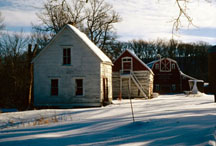
Knud and Kjerstle Ekre were Norwegian immigrants who arrived in the Kindred area on 17 May 1888. They lived with Knud's sister Kari and her husband until they could find a place of their own. In 1889 they moved to the "Nolan Place," in Barrie Township of Richland County. The Nolan Place had been homesteaded by Anthony Nolan and his sister Netty sometime during the 1860's. At that time it was called the "Four Corners," serving as a rest stop for stagecoaches traveling between Fort Ransom and Fort Abercrombie and by other travelers heading to Pembina.
Accommodations at the Four Corners consisted of a two-story oak log cabin with a sod roof. Nolan began constructing a second log cabin in 1871, but before it could be completed, the Travelers Insurance Company of Connecticut took the land into receivership. The Nolans moved off the property, and over the next few years several people would stay for awhile and then move on. Albert Ekre's parents moved onto the place in 1889, eventually purchasing it in 1891. The Ekre family lived in the original log cabin built by Nolan and in 1893 began renovating the partially built log cabin that had been started but never completed by Nolan. This second log cabin is where Albert Ekre was born and where the family continued to live until 1946 when they built a new two-story wood frame house.
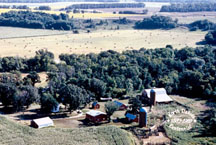
Aerial view of Ekre Farmstead
 |  | |
|---|---|---|
| Entrance to Farm | Original Barn | |
When Albert's parents died, the home place was divided among their children, with the original homestead site being left to Albert. The home place was originally named "Happy Hollow Ranch", but was renamed the "Happy Valley Ranch" by Albert sometime during the 1940's. Albert began farming in 1938 and eventually bought out all the original acres from his brothers and sisters. At the time of his gift to NDSU, the Happy Valley Ranch comprised 1600 acres and several buildings.
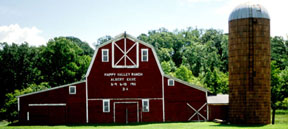
Mr. Ekre discussed the nature of his gift to NDSU with Dean Lund and others, several times under those oak trees and eventually his vision for the "Albert Ekre Grassland Preserve," began to take form. While Mr. Ekre had no children of his own he had a genuine interest in seeing young people succeed in agricultural pursuits. Mr. Ekre demonstrated this by allowing 4-H and FFA club members to conduct livestock judging trials on his property.
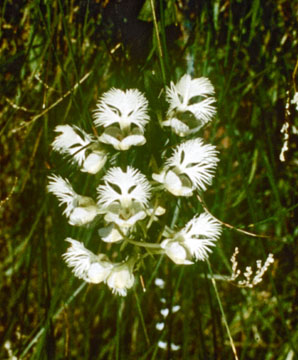
Mr. Ekre's interest in the Agricultural College stemmed from his attendance at winter short courses which were offered as a "Folk School." Members of the Botany Department and Animal & Range Sciences Department were regular visitors to the Happy Valley Ranch. Mr. Ekre was very proud to play host to rare and endangered plant species such as the Western Prairie Fringed Orchid (Platanthera praeclara) and rare and endangered species of butterflies. Of the 1300 flowering plants found in North Dakota, 861 are found on the farm or in the surrounding area. The farm had become more than the family homestead to Albert, he had developed an appreciation for the ecological significance of the unique habitats present on his land and he wanted to preserve this aspect.
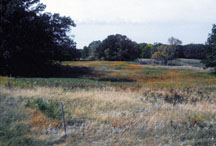
Albert Ekre had spent his lifetime repurchasing the original land base of the farmstead his parents had settled on more than a century ago. All he wanted now was a way to keep it together, forever. "I want you to promise me," he said to Dean Lund, "that you will never, ever sell the land and that you will not cut down these oak trees." Dean Lund wrote a letter to Albert documenting what had transpired. during the course of these meetings. This letter was later attached to Mr. Ekre's Last Will and Testament. And, there was one more thing, Mr. Ekre wanted a sign put up immediately declaring that this land would henceforth be known as the "Albert Ekre Grassland Preserve." The Will was written, the letter was attached, the sign was erected, and the community became aware that Mr. Ekre had given the land to the then College of Agriculture. Mr. Ekre died on 11 February 1989

Dr. William T. Barker of the then Department of Animal & Range Sciences organized the first advisory committee meeting and has managed the ranch for several years after it was given to the college. Dr. Barker was on this committee along with: Mr. Jim Haugen, representing the Sheyenne Valley Grazing Association; Mr. Irwin Huseth a local rancher; Mr. Mark Huseth a local rancher; Mr. Ken Sperry, a resident of Kindred; Mr. Frank Pearson a Kindred banker; Mr. Joe Milton, Jr. a local rancher; Mr. Russell Thane a local legislator; Dr. Jim Tilton, later replaced by Dr. Jerrold Dodd, Chairman of the Animal & Range Sciences Department at North Dakota State University; Dr. Roald Lund, Professor in the Plant Sciences Department at North Dakota State University and former Dean of the then College of Agriculture at NDSU; Mr. Don Hanson, Assistant to the Director of the NDSU Experiment Station; Dr. Lowell Satterlee, former Dean of the then College of Agriculture at NDSU; and Mr. Ron Peterson, Controller of the NDSU Development Foundation. This Advisory committee considered the conditions of the Albert Ekre Last Will & Testament, the budget situation, and the personnel that the College of Agriculture could devote to the Albert Ekre Grassland Preserve. A work-plan and a Mission Statement were then developed.
Mission Statement: To develop a demonstration ranch in the "Tall Grass Prairie" region of North Dakota dedicated to the educational and research efforts of the NDSU College of Agriculture for all dimensions of animal and range sciences to benefit North Dakota, regional, and national citizens.
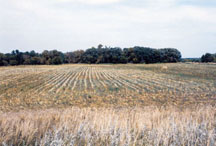
The Albert Ekre Grassland Preserve had no state funding for operating expenses; survival was dependent upon the Preserve's being self-supporting. The pasture land was leased out on bid and local farmers were hired to farm the cropland. The pasture was leased to Irwin and Mark Huseth; Jim and Jerell Haugen, and Carl Piper conducted the farming operations. This land-use generated sufficient operating funds to maintain the Preserve.
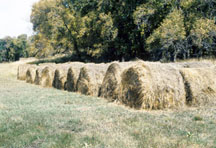
The Albert Ekre Grassland Preserve had no state funding for operating expenses; survival was dependent upon the Preserve's being self-supporting. The pasture land was leased out on bid and local farmers were hired to farm the cropland. The pasture was leased to Irwin and Mark Huseth; Jim and Jerell Haugen, and Carl Piper conducted the farming operations. This land-use generated sufficient operating funds to maintain the Preserve.
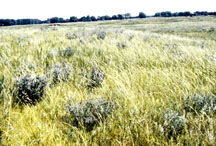
Leafy spurge (Euphorbia esula) was a problem on the Albert Ekre Grassland Preserve. Herbicide and insect control of leafy spurge research was initiated by Dr. Rod Lym of the Plant Sciences Department at NDSU and Dr. Robert Carlson and Dr. David Rider of the Entomology Department at NDSU. Dr. Bill Barker of the then Animal & Range Sciences Department at NDSU obtained funding from the Lake Agassiz Rural Community Development Committee and the Great Plains Agricultural Committee. Dr. Barker worked with Mr. Steve Fisher and Mr. Jeff Printz of the Natural Resource Conservation Service to establish a four-pasture, twice-over grazing system that could be grazed by cow-calf pairs and sheep for a six month season. This allowed for a demonstration project on the Albert Ekre Grassland Preserve to determine if multi-species grazing could control leafy spurge. the Great Plains Project funds were used to develop water and repair fences on all the Preserve's grazing lands.
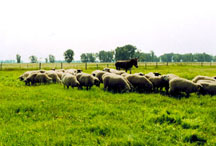
Sheep grazing on Leafy Spurge
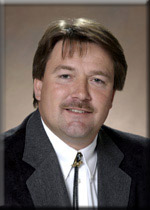
When the then College of Agriculture took possession of the land, the farmstead buildings were in dire need of maintenance. Fences were old and needed repair and all the water developments required improvements. Most of this maintenance was possible due largely from income generated by the leases. Additional funds were made available due to efforts of Dr. Bill Barker, Dr. Kevin Sedivec and Mr. and Mrs. A. R. Minch.
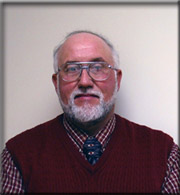
Dr. Roger Thompson, a Seattle physician and native North Dakotan died in April of 1992 leaving a major bequest to the NDSU Development Foundation. The Development Foundation approved the use of $80,000 of the Thompson bequest for the maintenance and development of facilities at the 1600 acre Albert Ekre Grassland Preserve. Instrumental in directing the Thompson funds for use at the preserve were Dr. Thompson's sister, Lois Thompson Minch and her Husband A.R. Minch who both attended NDSU during the 1940's. Their three children Roger, Ruth, and Robert are NDSU graduates. This bequest will make it possible to develop nature trails and facilities for demonstrating ecologically sound range management practices, including livestock corrals to permit winter feeding, feeding trials, and year-round livestock handling capabilities. Other improvements included plans for moving the two log cabins to permanent concrete foundations, remodeling the facilities to preserve their historic character, and repair other buildings at the site. Moving the cabins to concrete foundations has been completed and restoration efforts are underway. Restoration was undertaken by The Telephone Pioneers led by John Bartholomew of Fargo. Other restoration, repairs, and continuing general maintenance is conducted by Mr. Dennis Whitted, Research Specialist in the then Department of Animal & Range Sciences at NDSU. Mr. Whitted also assisted Dr. Barker in the management and general operation of the ranch.
Mr. Ekre asked only, that the land never be sold and that the oak trees not be cut down. One of the trees was felled in a storm, but the others still stand as living witness to Albert's vision and legacy.
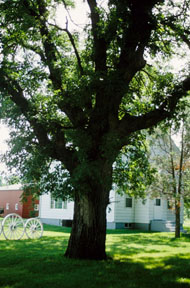
The future of the Ekre Preserve now lies in the "people" dimension. Albert had envisioned a place for students to come and learn about the land and agricultural production up-close. Possibly a bunkhouse may one day be built where students could spend summers while conducting research on the Ekre Preserve. A bunkhouse equipped with not only sleeping and kitchen facilities, but state-of-the art computer equipment Albert Ekre could not have imagined. This next dimension would be a graduate and undergraduate student program for conducting research. The work done in this regard would be result demonstration research asking such questions as: "Just how far can we increase stocking rates, without degrading the landscape?"
Albert Ekre bequeathed more than a beloved farmstead to the College of Agriculture, Food Systems, and Natural Resources, he bequeathed a vision for its role in the future of agriculture. His gift will be with us forever and his vision of land stewardship will be nurtured by young minds in their study of sound ecological management practices.
An expanded research program at the Ekre Preserve would serve to broaden the range of educational and research efforts already underway. These ongoing studies are directed toward agricultural production based on ecological principles compatible with the heritage of Albert Ekre's land stewardship. This expanded research program would also demonstrate the value of "hands-on" learning for students directed toward handling of livestock and management of the landscape. And also, to serve as an "outreach program" for sharing research results and applications in the surrounding areas. Without the Albert Ekre Grassland Preserve, the opportunity for doing any of this research in a meaningful way would not be possible.